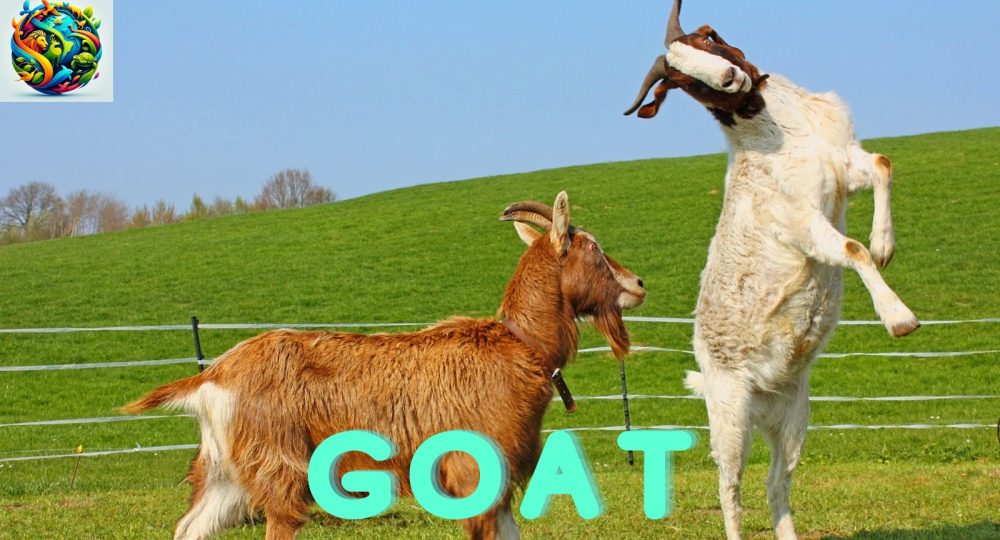Goats: From Farmyards to Family Companions

Goats: From Farmyards to Family Companions
Goats, with their diverse breeds and versatile nature, have carved a niche in both agricultural and domestic settings around the globe. These intelligent and curious animals, known for their ability to adapt to various environments, serve as a source of milk, meat, fibre, and even companionship. This article delves into the fascinating aspects of goats, including their unique characteristics and behaviours and the role they play in human lives.
Introduction
Domestic Specie (Capra aegagrus hircus), descendants of the wild Specie (Capra aegagrus), have been part of human society for thousands of years. Known for their hardiness and sociable nature, they are found in nearly every part of the world, thriving in environments ranging from arid deserts to lush mountainsides.
Amazing Fact
They have an extraordinary ability to climb steep and rocky terrain. Their sure-footedness is attributed to their unique hoof structure, consisting of two toes that can spread apart to increase balance and a soft, cushioned pad on the bottom that provides extra grip.
Habitat/Food
They are incredibly adaptable, capable of living in diverse habitats. They primarily feed on grass, leaves, twigs, and other vegetation, playing a crucial role in natural weed control. Their preference for varied diets helps them thrive in environments where other livestock might struggle.
Appearance
They exhibit a wide range of sizes, colours, and coat types, influenced by their specific breed. Characteristics include their distinctive beards, horizontal slit-shaped pupils, and horns that can vary in shape and size. Breeds range from the small, playful Pygmy to the larger, majestic Nubian, with coats that can be short, long, curly, or silky, and in colours that span from white and black to brown and gold.
Types/Subspecies
There are numerous goat breeds, each adapted to specific climates and purposes:
- Dairy breeds, such as the LaMancha and Alpine, are known for their milk production.
- Meat Breeds: Including the Boer and Spanish goats, prized for their quality meat.
- Fibre Breeds: Like the Angora and Cashmere goats, valued for their luxurious fibre.
- Dual-Purpose Breeds: Which are efficient both in milk and meat production?
Predator and Threat
While they are versatile and resilient, they face threats from predators such as wolves, coyotes, and large birds of prey, especially in rural and wild settings. Human activities, including habitat destruction and overgrazing, also pose significant risks to their populations.
Mating
They are seasonal breeders, with mating seasons varying by region and breed. Females, known as does, exhibit a gestation period of approximately 150 days, often giving birth to twins or triplets. Males, or bucks, can become particularly vocal and active during the breeding season.
How they Communicate
They communicate through a variety of vocalisations, body language, and even scent. They use bleats, grunts, and snorts to express emotions, call to their young, or signal the presence of food. Their rich social interactions underline the complexity of their behavioural patterns.
Movies on Goats
While not commonly the main subjects of films, goats have been featured in various documentaries and movies that highlight their intelligence, playful nature, and the bond they share with humans. They often symbolise rural life and the connection between humans and nature.
Pronunciation in Different Languages
The word “goat” is known worldwide, with its pronunciation varying across languages.
- Spanish: cabra
- French: chèvre
- Mandarin: 山羊 (shānyáng)
- German: Ziege
- Hindi: बकरी (bakri)
They are not only valuable for their agricultural products but also play a significant role in managing landscapes and enriching human lives with their companionship. Whether in a backyard or on a farm, these intelligent animals continue to captivate and provide for humans in myriad ways.
FAQs
How do they benefit the environment?
- Answer: They help control invasive species by browsing on a wide variety of plants, reducing the need for chemical weed control and promoting biodiversity.
Can they be kept as pets?
- Answer: Yes, they can make great pets due to their friendly and curious nature. However, they require proper care, space to roam, and social interaction with other goats.
What is the difference between a goat and a sheep?
- Answer: Goats and sheep are different species with distinct physical and behavioural traits. They have straighter hair, more upright ears, and are generally more independent and curious than sheep, which have woolly coats and a more flock-oriented behaviour.
How can I start raising them?
- Answer: Research is key. Consider your goals (milk, meat, fibre, pets), available space, local zoning laws, and breed characteristics. Starting with a small number of goats and learning as you go can be a rewarding approach to goat farming.





